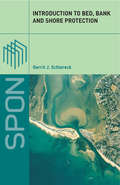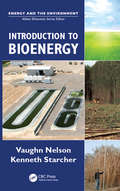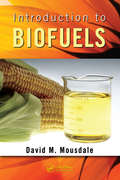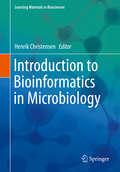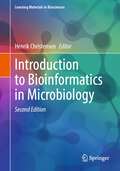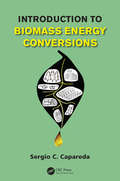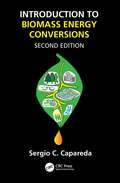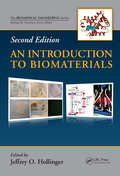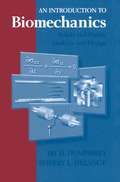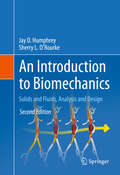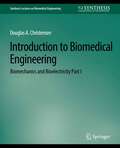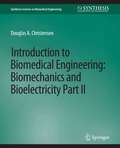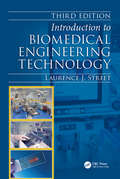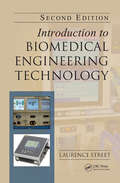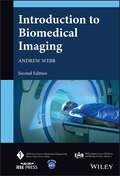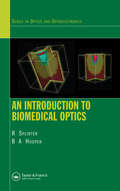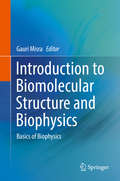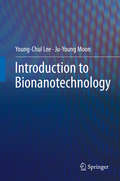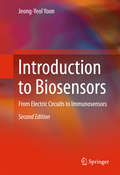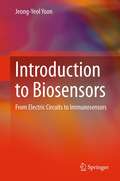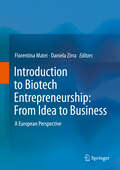- Table View
- List View
Introduction to Bed, Bank and Shore Protection
by Gerrit J. SchiereckIntroduction to Bed, Bank and Shore Protection provides students and professional engineers with the understanding and guidance to prevent the erosion of movable beds, banks and shorelines. In a world of rising sea levels and extreme weather conditions, these skills are increasingly important to the engineer as well as the wider community. The book starts with the underlying scientific principles behind hydraulics and soil mechanics and applies them to common practical situations for the protection of coastal and river beds, banks and shores. Based on the author's twenty years of experience, this blend of theory and practice provides the reader with useful knowledge that can be applied to a wide range of situations for the protection of the environment.
Introduction to Bioenergy
by Vaughn C. Nelson Kenneth L. StarcherExplore a Major Component of Renewable Energy Introduction to Bioenergy takes a look at energy from biomass (thermal energy, power, liquid fuels, and biogas) and envisions a sustainable future fueled by renewable energy. From production to conversion to heat, power, and biofuel, this book breaks down the science of bioenergy and explains the major processes for its production, conversion, and use. Covers Solar Energy, Bioenergy, and Biomass Resources The book begins with an introduction to solar energy (the source of bioenergy) and then moves on to describe bioenergy, biomass, chemical conversion, and the renewable energy processes involved. The authors cover measurement energy parameters, analysis of data, and the prediction of energy production for different bio products. They also consider the institutional, environmental, and economic concerns surrounding bioenergy. An all-inclusive resource covering a rapidly-advancing field, this book: Explores the impact of climate change and global warming on the production of biomass Describes the positive and negative effects of biomass production on ecosystems and biodiversity Illustrates the use of biomass for the production of electricity Considers the replacement of fossil fuels with biofuels, biofuel production, and emerging technologies Addresses institutional and environmental issues relevant to bioenergy Discusses factors impacting the economic feasibility of renewable energy systems Introduction to Bioenergy defines major processes for the production, conversion, and use of bioenergy. A book suitable for coursework or self-study, this essential work serves students and practicing professionals in the renewable energy, environmental science, agriculture engineering, and biology fields.
Introduction to Bioenergy
by Vaughn C. Nelson Kenneth L. StarcherExplore a Major Component of Renewable Energy Introduction to Bioenergy takes a look at energy from biomass (thermal energy, power, liquid fuels, and biogas) and envisions a sustainable future fueled by renewable energy. From production to conversion to heat, power, and biofuel, this book breaks down the science of bioenergy and explains the major processes for its production, conversion, and use. Covers Solar Energy, Bioenergy, and Biomass Resources The book begins with an introduction to solar energy (the source of bioenergy) and then moves on to describe bioenergy, biomass, chemical conversion, and the renewable energy processes involved. The authors cover measurement energy parameters, analysis of data, and the prediction of energy production for different bio products. They also consider the institutional, environmental, and economic concerns surrounding bioenergy. An all-inclusive resource covering a rapidly-advancing field, this book: Explores the impact of climate change and global warming on the production of biomass Describes the positive and negative effects of biomass production on ecosystems and biodiversity Illustrates the use of biomass for the production of electricity Considers the replacement of fossil fuels with biofuels, biofuel production, and emerging technologies Addresses institutional and environmental issues relevant to bioenergy Discusses factors impacting the economic feasibility of renewable energy systems Introduction to Bioenergy defines major processes for the production, conversion, and use of bioenergy. A book suitable for coursework or self-study, this essential work serves students and practicing professionals in the renewable energy, environmental science, agriculture engineering, and biology fields.
Introduction to Biofuels (Mechanical And Aerospace Engineering Ser.)
by David M. MousdaleWhat role will biofuels play in the scientific portfolio that might bring energy independence and security, revitalize rural infrastructures, and wean us off of our addiction to oil? The shifting energy landscape of the 21st century, with its increased demand for renewable energy technology, poses a worrying challenge. Discussing the multidisciplin
Introduction to Bioinformatics in Microbiology (Learning Materials in Biosciences)
by Henrik ChristensenThis textbook introduces to the basic concepts of bioinformatics and enhances students’ skills in using software and tools relevant for investigations in microbiology. The most relevant methods to analyze data are shown and readers are introduced on how to draw valid conclusions based on the results obtained. Software and servers which are free to use on the internet are presented and more advanced stand-alone programs are suggested as a second option. Exercises and training quizzes are provided at the end of each chapter to facilitate learning. The book targets Ph. D. students and advanced undergraduates in microbiology, biotechnology, and (veterinary) medicine with little to basic knowledge in bioinformatics.
Introduction to Bioinformatics in Microbiology (Learning Materials in Biosciences)
by Henrik ChristensenThis updated and extended second edition of the textbook introduces the basic concepts of bioinformatics and enhances students' skills in the use of software and tools relevant to microbiology research. It discusses the most relevant methods for analysing data and teaches readers how to draw valid conclusions from the observations obtained. Free software and servers available on the Internet are presented in an updated version of 2023 and more advanced stand-alone software is proposed as a second option. In addition, new tools for microbial genome analysis and new flowcharts that complement the didactic elements have been added. Exercises and training questionnaires are included at the end of each chapter to facilitate learning. The book is aimed at Ph.D. students and advanced undergraduate students in microbiology, biotechnology, and (veterinary) medicine with little or basic knowledge of bioinformatics.
Introduction to Biomass Energy Conversions
by Sergio CaparedaThe potential that biomass energy has to supplement traditional fuels and reduce greenhouse gas emissions has put it front and center in the plan to replace fossil-based fuels with renewable fuels. While much has been written about biomass conversions, no single textbook contains all the information needed to teach a biomass conversion course-until
Introduction to Biomass Energy Conversions
by Sergio CaparedaIntroduction to Biomass Energy Conversions explores biomass energy conversions and characterization using practical examples and real-world scenarios. It begins with biomass resource estimation and extends to commercialization pathways for economical biomass conversion into high-value materials, chemicals, and fuels. With extended discussions of new sustainability issues in biofuels production, such as carbon capture and sequestration, the second edition has been updated with carbon footprint work life cycle analysis, the growing circular economy, and newer research directions of biomass resources, such as graphene production from biochar. This book covers thermo-chemical conversion processes, including torrefaction, pyrolysis, gasification and advanced gasification, biomass liquefaction, and combustion. This book is intended for senior undergraduate students taking Renewable Energy Conversions, Bio Energy, Biomass Energy, Introduction to Biofuels, and Sustainability Engineering courses. This book also features end-of-chapter problems, exercises, and case studies with a Solutions Manual available for instructors.
Introduction to Biomass Energy Conversions
by Sergio CaparedaIntroduction to Biomass Energy Conversions explores biomass energy conversions and characterization using practical examples and real-world scenarios. It begins with biomass resource estimation and extends to commercialization pathways for economical biomass conversion into high-value materials, chemicals, and fuels. With extended discussions of new sustainability issues in biofuels production, such as carbon capture and sequestration, the second edition has been updated with carbon footprint work life cycle analysis, the growing circular economy, and newer research directions of biomass resources, such as graphene production from biochar. This book covers thermo-chemical conversion processes, including torrefaction, pyrolysis, gasification and advanced gasification, biomass liquefaction, and combustion. This book is intended for senior undergraduate students taking Renewable Energy Conversions, Bio Energy, Biomass Energy, Introduction to Biofuels, and Sustainability Engineering courses. This book also features end-of-chapter problems, exercises, and case studies with a Solutions Manual available for instructors.
An Introduction to Biomaterials (Biomedical Engineering Ser.)
by Jeffrey O. HollingerA practical road map to the key families of biomaterials and their potential applications in clinical therapeutics, Introduction to Biomaterials, Second Edition follows the entire path of development from theory to lab to practical application. It highlights new biocompatibility issues, metrics, and statistics as well as new legislation for intelle
An Introduction to Biomechanics: Solids and Fluids, Analysis and Design
by Jay D. Humphrey Sherry DeLangeDesigned to meet the needs of undergraduate students, "Introduction to Biomechanics" takes the fresh approach of combining the viewpoints of both a well-respected teacher and a successful student. With an eye toward practicality without loss of depth of instruction, this book seeks to explain the fundamental concepts of biomechanics. With the accompanying web site providing models, sample problems, review questions and more, Introduction to Biomechanics provides students with the full range of instructional material for this complex and dynamic field.
An Introduction to Biomechanics: Solids and Fluids, Analysis and Design
by Jay D. Humphrey Sherry L. O’RourkeThis book covers the fundamentals of biomechanics. Topics include bio solids, biofluids, stress, balance and equilibrium. Students are encouraged to contextualize principles and exercises within a “big picture” of biomechanics. This is an ideal book for undergraduate students with interests in biomedical engineering.
Introduction to Biomedical Engineering: Biomechanics and Bioelectricity - Part I (Synthesis Lectures on Biomedical Engineering)
by Douglas ChristensenIntended as an introduction to the field of biomedical engineering, this book covers the topics of biomechanics (Part I) and bioelectricity (Part II). Each chapter emphasizes a fundamental principle or law, such as Darcy's Law, Poiseuille's Law, Hooke's Law, Starling's Law, levers, and work in the area of fluid, solid, and cardiovascular biomechanics. In addition, electrical laws and analysis tools are introduced, including Ohm's Law, Kirchhoff's Laws, Coulomb's Law, capacitors and the fluid/electrical analogy. Culminating the electrical portion are chapters covering Nernst and membrane potentials and Fourier transforms. Examples are solved throughout the book and problems with answers are given at the end of each chapter. A semester-long Major Project that models the human systemic cardiovascular system, utilizing both a Matlab numerical simulation and an electrical analog circuit, ties many of the book's concepts together. Table of Contents: Basic Concepts / Darcy's Law / Poiseuille's Law: Pressure-Driven Flow Through Tubes / Hooke's Law: Elasticity of Tissues and Compliant Vessels / Starling's Law of the Heart, Windkessel Elements and Volume / Euler's Method and First-Order Time Constants / Muscle, Leverage, Work, Energy and Power
Introduction to Biomedical Engineering: Biomechanics and Bioelectricity - Part II (Synthesis Lectures on Biomedical Engineering)
by Douglas ChristensenIntended as an introduction to the field of biomedical engineering, this book covers the topics of biomechanics (Part I) and bioelectricity (Part II). Each chapter emphasizes a fundamental principle or law, such as Darcy's Law, Poiseuille's Law, Hooke's Law, Starling's Law, levers, and work in the area of fluid, solid, and cardiovascular biomechanics. In addition, electrical laws and analysis tools are introduced, including Ohm's Law, Kirchhoff's Laws, Coulomb's Law, capacitors, and the fluid/electrical analogy. Culminating the electrical portion are chapters covering Nernst and membrane potentials and Fourier transforms. Examples are solved throughout the book and problems with answers are given at the end of each chapter. A semester-long Major Project that models the human systemic cardiovascular system, utilizing both a Matlab numerical simulation and an electrical analog circuit, ties many of the book's concepts together. Table of Contents: Ohm's Law: Current, Voltage and Resistance / Kirchhoff's Voltage and Current Laws: Circuit Analysis / Operational Amplifiers / Coulomb's Law, Capacitors and the Fluid/Electrical Analogy / Series and Parallel Combinations / Thevenin Equivalent Circuits / Nernst Potential: Cell Membrane Equivalent Circuit / Fourier Transforms: Alternating Currents (AC)
Introduction to Biomedical Engineering Technology
by Laurence J. StreetThis new edition provides major revisions to a text that is suitable for the introduction to biomedical engineering technology course offered in a number of technical institutes and colleges in Canada and the US. Each chapter has been thoroughly updated with new photos and illustrations which depict the most modern equipment available in medical technology. This third edition includes new problem sets and examples, detailed block diagrams and schematics and new chapters on device technologies and information technology.
Introduction to Biomedical Engineering Technology
by Laurence J. StreetMedical devices are often very complex, but while there are differences in design from one manufacturer to another, the principles of operation and, more importantly, the physiological and anatomical characteristics on which they operate are universal. Introduction to Biomedical Engineering Technology, Second Edition explains the uses and applicati
Introduction to Biomedical Engineering Technology
by Laurence J. StreetThis new edition provides major revisions to a text that is suitable for the introduction to biomedical engineering technology course offered in a number of technical institutes and colleges in Canada and the US. Each chapter has been thoroughly updated with new photos and illustrations which depict the most modern equipment available in medical technology. This third edition includes new problem sets and examples, detailed block diagrams and schematics and new chapters on device technologies and information technology.
Introduction to Biomedical Imaging (IEEE Press Series on Biomedical Engineering)
by Andrew WebbIntroduction to BiomedicalImaging A state-of-the-art exploration of the foundations and latest developments in biomedical imaging technology In the newly revised second edition of Introduction to Biomedical Imaging, distinguished researcher Dr. Andrew Webb delivers a comprehensive description of the fundamentals and applications of the most important current medical imaging techniques: X-ray and computed tomography, nuclear medicine, ultrasound, magnetic resonance imaging, and various optical-based methods. Each chapter explains the physical principles, instrument design, data acquisition, image reconstruction, and clinical applications of its respective modality. This latest edition incorporates descriptions of recent developments in photon counting CT, total body PET, superresolution-based ultrasound, phased-array MRI technology, optical coherence tomography, and iterative and model-based image reconstruction techniques. The final chapter discusses the increasing role of artificial intelligence/deep learning in biomedical imaging. The text also includes a thorough introduction to general image characteristics, including discussions of signal-to-noise and contrast-to-noise. Perfect for graduate and senior undergraduate students of biomedical engineering, Introduction to Biomedical Imaging, 2nd Edition will also earn a place in the libraries of medical imaging professionals with an interest in medical imaging techniques.
Introduction to Biomedical Imaging: Physics, Engineering And Clinical Applications (IEEE Press Series on Biomedical Engineering)
by Andrew WebbIntroduction to BiomedicalImaging A state-of-the-art exploration of the foundations and latest developments in biomedical imaging technology In the newly revised second edition of Introduction to Biomedical Imaging, distinguished researcher Dr. Andrew Webb delivers a comprehensive description of the fundamentals and applications of the most important current medical imaging techniques: X-ray and computed tomography, nuclear medicine, ultrasound, magnetic resonance imaging, and various optical-based methods. Each chapter explains the physical principles, instrument design, data acquisition, image reconstruction, and clinical applications of its respective modality. This latest edition incorporates descriptions of recent developments in photon counting CT, total body PET, superresolution-based ultrasound, phased-array MRI technology, optical coherence tomography, and iterative and model-based image reconstruction techniques. The final chapter discusses the increasing role of artificial intelligence/deep learning in biomedical imaging. The text also includes a thorough introduction to general image characteristics, including discussions of signal-to-noise and contrast-to-noise. Perfect for graduate and senior undergraduate students of biomedical engineering, Introduction to Biomedical Imaging, 2nd Edition will also earn a place in the libraries of medical imaging professionals with an interest in medical imaging techniques.
An Introduction to Biomedical Optics (Series In Optics And Optoelectronics Ser.)
by Robert SplinterMany universities now offer a course in biomedical optics, but lack a textbook specifically addressing the topic. Intended to fill this gap, An Introduction to Biomedical Optics is the first comprehensive, introductory text describing both diagnostic and therapeutic optical methods in medicine. It provides the fundamental background needed for grad
Introduction to Biomolecular Structure and Biophysics: Basics of Biophysics
by Gauri MisraThis comprehensive book presents a modern concept in biophysics based on recently published research. It highlights various aspects of the biophysical fundamentals and techniques that are currently used to study different physical properties of biomolecules, and relates the biological phenomenon with the underlying physical concepts. The content is divided into nine chapters summarizing the structural details of proteins, including recently discovered novel folds, higher order structures of nucleic acids, as well as lipids and the physical forces governing the macromolecular interactions which are essential for the various biological processes. It also provides insights into the recent advances in biophysical techniques including Hydrogen Deuterium Exchange with Mass Spectrometry (HDX-MS), Small angle X-ray scattering (SAXS) and Cryo Electron Microscopy (cryo EM), supplemented with interesting experimental data. It is a valuable reference resource for anyone with a desire to gain a better understanding of the fundamentals of biophysical concepts and techniques of important biomolecules.
Introduction to Bionanotechnology
by Young-Chul Lee Ju-Young MoonThis is a comprehensive overview of bionanotechnology to students in nanotechnology, biotechnology, bionanotechnology, related fields such as biology, chemistry, physics, and materials science and also everyone who is interested in this research area. It describes the definition of bionanomaterials, how they can be synthesized, characterized and applied in different fields. The current status and future of bionanotechnology, as well as its advantages and limitations, are comprehensively discussed throughout the book. This is an entry-level book which is easy for readers to understand its contents. In this book, we tried to identify the definition of bionanotechnology. Briefly, Bionanotechnology is the emerging research field that comes from the intersection of nanotechnology and biotechnology. Nanotechnology is referring to the design, development, and application of materials which at least one dimension at nanometer scale meanwhile biotechnology is developed based on knowledge about living systems and organisms to create or improve different products. The association of nanotechnology and biotechnology pave a way to develop a hybrid technology with unique features. Thus, this novel technology will be used to improve our living standard in different aspects from developing new medicine, food, and functional cosmetics, introducing new methods to analyze and treat cancer to protect environmental problems.
Introduction to Biosensors: From Electric Circuits to Immunosensors
by Jeong-Yeol YoonThis book equips students with a thorough understanding of various types of sensors and biosensors that can be used for chemical, biological, and biomedical applications, including but not limited to temperature sensors, strain sensor, light sensors, spectrophotometric sensors, pulse oximeter, optical fiber probes, fluorescence sensors, pH sensor, ion-selective electrodes, piezoelectric sensors, glucose sensors, DNA and immunosensors, lab-on-a-chip biosensors, paper-based lab-on-a-chip biosensors, and microcontroller-based sensors. The author treats the study of biosensors with an applications-based approach, including over 15 extensive, hands-on labs given at the end of each chapter. The material is presented using a building-block approach, beginning with the fundamentals of sensor design and temperature sensors, and ending with more complicated biosensors.New to this second edition are sections on op-amp filters, pulse oximetry, meat quality monitoring, advanced fluorescent dyes, autofluorescence, various fluorescence detection methods, fluoride ion-selective electrode, advanced glucose sensing methods including continuous glucose monitoring, paper-based lab-on-a-chip, etc. A new chapter on nano-biosensors and an appendix on microcontrollers make this textbook ideal for undergraduate engineering students studying biosensors. It can also serve as a hands-on guide for scientists and engineers working in the sensor or biosensor industries.
Introduction to Biosensors: From Electric Circuits to Immunosensors
by Jeong-Yeol YoonBiosensors: From Electric Circuits to Immunosensors discusses underlying circuitry of sensors for biomedical and biological engineers as well as biomedical sensing modalities for electrical engineers while providing an applications-based approach to the study of biosensors with over 13 extensive, hands-on labs. The material is presented using a building-block approach, beginning with the fundamentals of sensor design and temperature sensors and ending with more complicated biosensors.
Introduction to Biotech Entrepreneurship: A European Perspective
by Florentina Matei Daniela ZirraPrimarily intended for biotechnology graduates, this handbook provides an overview of the requirements, opportunities and drawbacks of Biotech Entrepreneurship, while also presenting valuable training materials tailored to the industrial and market reality in the European Biotech Business. Potential investors and business consultants will find essential information on the benefits and potential risks involved in supporting biotech businesses. Further, the book addresses a broad range of Biotechnology fields, e.g. food biotech, industrial biotech, bioinformatics, animal and human health. Readers will learn the essentials of creating innovations, founding a biotech start-up, business management strategies, and European funding sources. In addition, the book discusses topics such as intellectual property management and innovation transfer.The book offers a comparative analysis of different countries’ perspectives and reviews the status quo in Western and Eastern European regions, also in comparison with other leading biotech countries such as the USA and Canada. A long list of potentially profitable biotech start-up ideas and a collection of success stories involving European companies are also included.The book is based on the Erasmus+ Strategic Partnership project “Supporting biotechnology students oriented towards an entrepreneurial path” (www.supbioent.usamv.ro), which involved the collaboration of Life Sciences and Economics departments at higher education institutions throughout Western and Eastern Europe.
